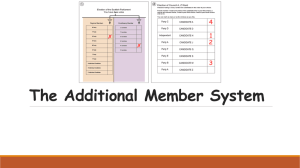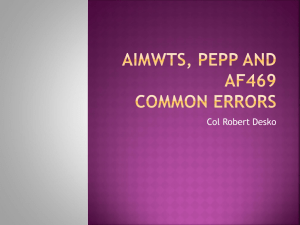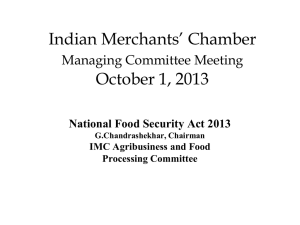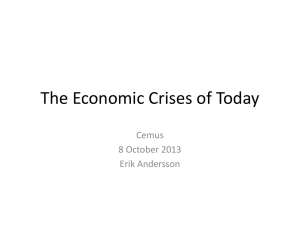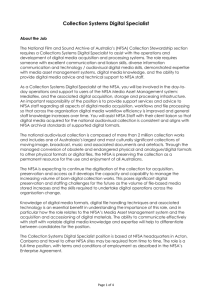Powerpoint PPT - India China Institute
advertisement
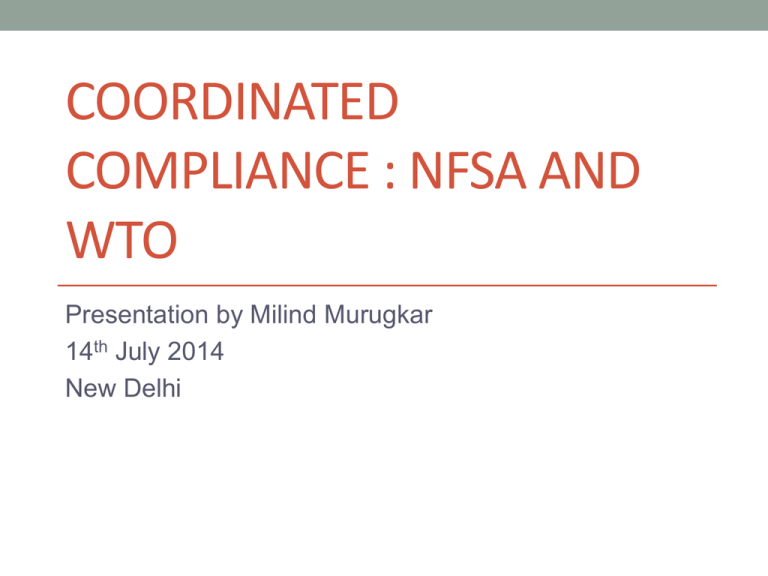
COORDINATED COMPLIANCE : NFSA AND WTO Presentation by Milind Murugkar 14th July 2014 New Delhi WTO’s Ministerial in Bali • India’s Public Distribution System and the recently legislated National Food Security Act emerged as the most contentious issues . • During his visit just before the Bali ministerial WTO ‘s Director General made critical comments on the NFSA • Attack also came from the US ambassador to the WTO. Perceived concerns 1. 2. 3. India was about to breach the AMS limit even before NFSA. The tendency would exacerbate after NFSA India’s food stocks pose threat to the stability of the International market and NFSA was thought to intensify this threat further. Logic of the Objections •The aim of the Agreement On Agriculture is to reduce protectionism in the international trade. •Protection is achieved through : price support , other non product specific support and tariffs. •Tariffs is a non issue for India. The issue of non product specific subsidy will be addressed towards the end of the presentation. India’s MSPs for wheat and rice and WTO • India’s MSPs for wheat and rice have breached the bound levels of Aggregate Measure of Support (AMS) for these crops. • NFSA would entail incentivizing wheat and rice production through higher MSP thus breach the AMS limit further and frequently. • Higher MSPs leads to building up of food stocks with the FCI which, if unloaded in the international market, would harm the interests of the exporters in other countries. India’s Defense of the NFSA and MSP • Large section of the population is food insecure. • Ensuring the food security of its population is the sovereign right of India. • Most of the Indian farmers are resource poor and the protection through MSPs is legitimate. Does PDS and NFSA violate AoA? • Unfair clauses and technical issues in the AoA: 1.Developing countries like India have a limit for the AMS for each product as well as for the total AMS of all the products. Where as the developed countries have no upper limit for individual product. This has implications for India’s wheat and rice markets. • Method of estimating AMS: The current AMS is found out by comparing the current AMS with the international price for that product that prevailed during the base year of 1986-88. The AMS thus estimated is notional. • India’s notification of AMS in the base period was in terms of INR . And WTO’s rules demand that India’s notification thereafter should also be in terms of INR. • But this method does not take into the change in INR –Dollar exchange rate. This aspect also makes the estimated AMS notional. • India has been notifying its AMS in dollar terms contrary to the WTO rules. And this method shows no breaching of the AMS level. • If the AMS is estimated strictly as per the WTO rules , India has breached AMS limit for wheat and rice several times in the past. • India can defend its price support policy by invoking the clause that is unfair (disparity between the provisions for LDCs and DCs) and also pointing out the notional aspect of the AMS. • The new method of AMS estimation is being worked out in the WTO. • So, India is likely to have defense against its price support policy…………….. But its huge stocks of food grains way beyond its buffer norms are indefensible. Indefensible food stocks • The food grain stocks pose a threat to the stability of international market. • Also, such excessive stock accumulation is against the interests of the poor in India. • Why should FCI procure so much? • Is over procurement intrinsic to the PDS? 0 20 40 60 Why stockpile ? 1970 1980 1990 year procurement 2000 pds 2010 Procurement and PDS • The previous graph confirms rise in PDS lags rise in procurement • Since 1989, procurement has exceeded PDS sales every year. • Close match between procurement and PDS in the 70s and 80s. • This trend does not extend beyond the early 90s. • The reasons for excessive procurement are complex. • Decreased supply through PDS post TPDS , steep increase in MSP in recent past , open ended procurement and tendency of the government to err on one side , all contribute to stockpiling. • The paradox is that often during the period of high stocks exports were restricted. The way out • WTO doesn’t have any objection to consumer subsidies. • India can switch to cash transfers that are WTO compatible. • Export restrictions should be removed and MSPs can work as a price floor. Other advantages of cash transfers • Nearly 50% of the food grains meant for the poor leak away. • Aadhar linked cash transfers have potential to plug the leakages. • Cash transfers can remove the bias against coarse cereals built in the present PDS. • Cash Transfers thus help achieve coordinated compliance with the WTO rules and help the poor. What about farmers? • Surplus producing farmers from the irrigation belt can benefit from international prices. • They will be protected through price floor whenever prices fall sharply. • Most of the farmers in India are resource poor, dry land agriculturists. They need protection too. • WTO allows non product specific subsidies. Non-Product Subsidies • These non product subsidies mostly include input subsidies on fertlizer, electricity etc. • India is well within the bounds of the WTO limit on these subsidies. • But the poor, dry land agriculturists derive insignificant benefits from these subsidies. • For these farmers support through MNREGA is crucial. MGNREGA • MNREGA helps these farmers by raising their incomes , by creating assets that enhance the productivity of these farmers. • MNREGA doesn’t violate WTO rules as it doesn’t influence the market prices of the farmers’ produce. Co-Ordinated Compliance • Cash Transfers, free trade in agriculture and MNREGA can achieve the coordinated compliance that WTO demands, safeguarding the interests of poor consumers and poor farmers. • Thank you.
